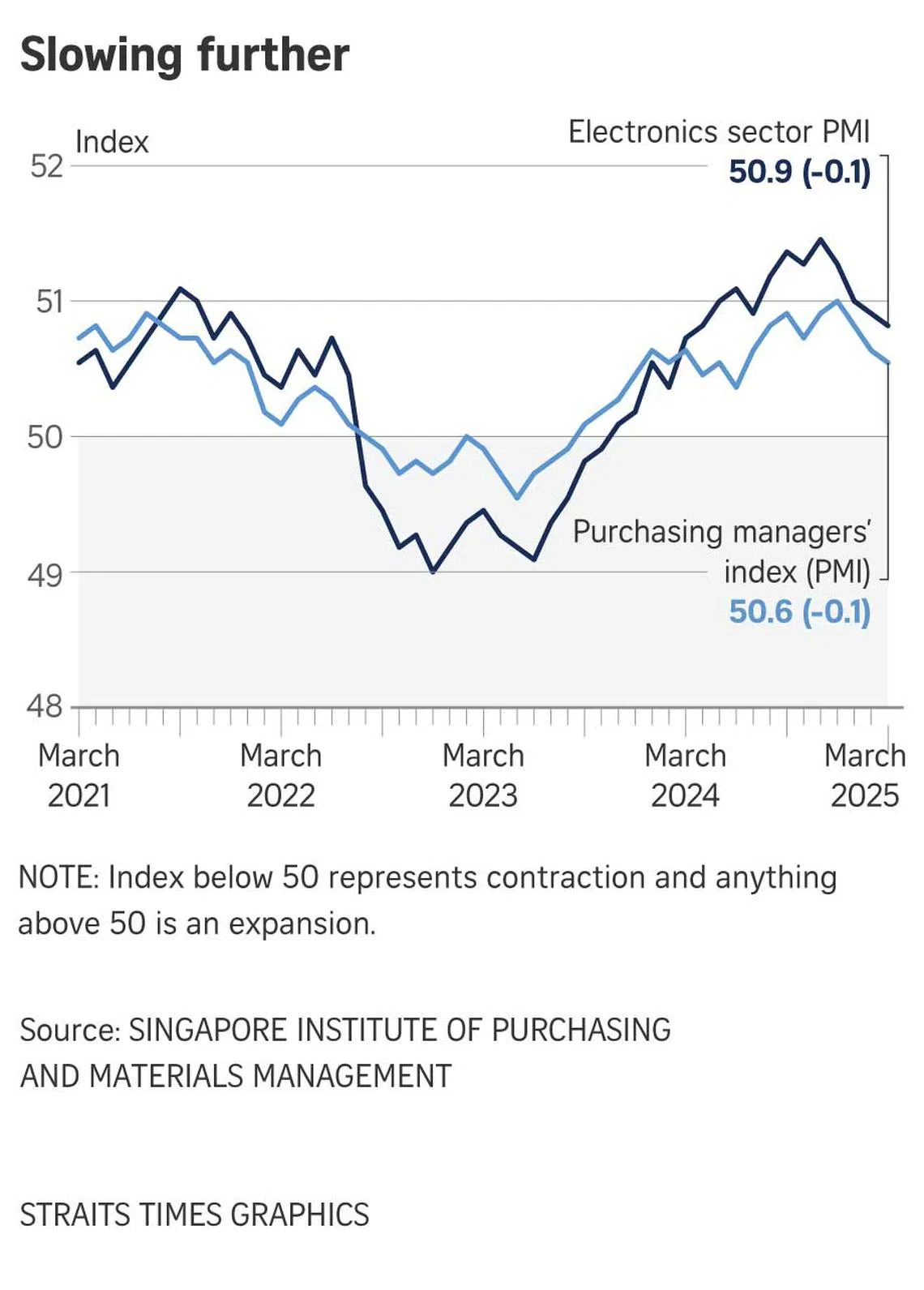Singapore’s manufacturing indicators in March at lowest level in 8 months
Sign up now: Get ST's newsletters delivered to your inbox

The PMI for electronics, which accounts for a hefty chunk of Singapore’s manufacturing sector, dipped by 0.1 point, to 50.9.
PHOTO: ST FILE
Follow topic:
SINGAPORE – Singapore’s manufacturing sector is showing signs of even weaker growth ahead, with leading indicators declining a third consecutive month in March 2025 to their lowest level in eight months.
The purchasing managers’ index (PMI), a barometer of the sector’s activities, stood at 50.6 points in March, 0.1 point lower than February’s 50.7 points. Readings above 50 indicate growth; those below point to contraction.
Falling in tandem was the PMI for electronics, which accounts for a hefty chunk of Singapore’s manufacturing sector. It also dipped by 0.1 point, to 50.9, according to data from the Singapore Institute of Purchasing and Materials Management on April 2.
Notably, the slowdown was felt across Asia, with the Asean PMI index also retreating in tandem with India’s, as well as those of the North Asian economies of Taiwan and South Korea.
Meanwhile, the declines in the PMIs of Taiwan, Thailand and the Philippines brought them into contraction territory, joining Malaysia and South Korea.
Bucking the trend were China and Vietnam, which registered improvements.
In Singapore, while the majority of sub-indexes of the overall PMI and that of electronics posted declines, stocks of raw materials or components that go into the final product, as well as supplier deliveries, rose, albeit marginally.
Experts told The Straits Times that the slowdown was to be expected, given the escalation in US President Donald Trump’s beggar-thy-neighbour trade policy, culminating in the all-out “Liberation Day” offensive expected on April 2 US time.
UOB associate economist Jester Koh said this has caused uncertainty surrounding US trade policy to hit “new record highs” as reflected in the Trade Policy Uncertainty (TPU) index.
“This is materially above levels seen during the 2018-2019 trade wars under Trump’s first term,” he said.
Maybank economist Brian Lee said that this was having an impact on businesses and consumers overseas, who have turned “more cautious with their spending”.
At home, the challenging trade outlook has cooled manufacturers’ hiring sentiments, with the employment sub-index softening for a second consecutive month, he noted.
Focusing on the changes in the PMI sub-indexes, Associate Professor Goh Puay Guan from NUS Business School’s Department of Analytics and Operations said that the rise in supplier deliveries, coupled with a fall in backlog orders, suggests that “supply is catching up to demand”.
Meanwhile, DBS senior economist Chua Han Teng noted that input prices of raw materials and components within the headline manufacturing PMI have contracted for a second consecutive month, marking the first such decline since the onset of the Covid-19 pandemic in early 2020.
He said that this suggested “an easing of manufacturing input costs, with the possibility of greater disinflationary risks arising from weaker global demand, should escalating trade tensions trigger a broad global trade and manufacturing economic downturn”.
Looking ahead, Maybank’s Mr Lee expects the manufacturing sector to weaken further “as Trump ramps up his tariff arsenal with a cocktail of reciprocal tariffs and sector duties on chips and pharmaceutical goods”. “We are forecasting gross domestic product growth to moderate to 2.6 per cent in 2025, down from 4.4 per cent in 2024,” he said.

OCBC chief economist Selena Ling said: “The key takeaway from the March data is that the momentum from both manufacturing and electronics has likely peaked already in late 2024.”
Ms Ling, who is also the bank’s head of global markets research and strategy, said: “While the expansion is likely to be sustained in the coming months, we are also likely to see choppier days ahead.”
Even though Singapore has a free trade agreement with the US, the 2025 trade report by the US Trade Representative has a list of grievances that could pave the way for tariffs to be imposed on Singapore exports.
Ms Ling said that the list included “legal and financial services, medical products and pharmaceuticals, as well as intellectual property protection (specifically illegal streaming activities)”.
“Basically the net is cast very wide and there are many ways to skin the cat. Essentially, this means that if the US wants to impose tariffs, it can always find a reason to do so,” she added.


